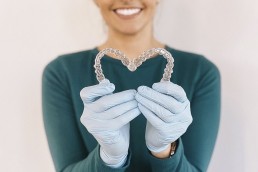During the Retainer Phase — also known as The Retention Phase — we remove your dental braces and any other orthodontic devices used to correctly align your teeth. At that point, you’ll be free of bands and brackets or any Invisalign attachments. You can eat whatever you want and enjoy the feeling of smooth, clean teeth.
However, keep in mind that you aren’t quite done with your orthodontic treatment yet.
Next up, our orthodontic team will create a custom retainer — typically the day you get your appliances removed — that will continue to straighten your teeth, improve your smile, and ensure that your teeth don’t shift back to their original positions. Here’s what to expect during the retainer phase:
Three Types of Retainers
The most common type of retainer is called the “Hawley” (or loop) retainer — a thin, tongue-shaped piece molded to fit your mouth, using a wire to hold your teeth in position. This type of retainer is simple, durable and can be easily taken out and put back in, making it a removable aligner.
Another popular style is a clear style (or “hard cast”) similar to transparent braces or Invisalign removable aligners. These retainers are custom-made of thin plastic. The main advantage of this style is that they are invisible and easy to remove. However, in cases where an expander or a quad was required, they do not hold the newly gained width as effectively as a loop retainer.
The last option is a fixed retainer, which is a popular choice for the lower teeth. These retainers are not removable, but they are also not visible. A wire is bonded to the backside of the lower canine teeth and may remain in your mouth indefinitely. We recommend this type of retainer when you have a high risk of your teeth reverting back to their pre-braces position.
Your Heart Says Thank you for Your Healthy, Straight Teeth
Adjusting to Your Retainer
Retainers are very easy to adjust to, and you won’t even notice them after a couple of weeks. It may be a little harder to talk at first, but that shouldn’t last long. The hardest part will be to remember to take your retainers out when eating or brushing your teeth – but then putting them back in as soon as you’re done. We have had many patients call us because they accidentally threw away their retainer in a napkin after lunch.
Initially, we recommend wearing your retainer 24/7 for the first ten weeks. After that period of time, we typically transition you into only wearing your retainer at night. If you decrease the frequency in which you wear your retainer, and you feel a tightness when you put it back in, that’s a sign that you waited too long to wear the retainer again. Increase your frequency and see if that feels better. If you’re wearing your retainer every night and still feeling a tightness, give us a call.
Caring for Your Retainer
All retainers need proper cleaning. You can use a toothbrush to clean your retainer, but we recommend using special retainer cleaner (or denture cleaner). Fixed retainers should be cleaned while brushing and flossing. Also, we don’t recommend exposing your retainer to high heat by washing it in hot water, as it could cause the retainer to warp into a new shape.
And lastly, always remember to bring your retainer with you to your orthodontist appointments. Proper use of a retainer will help make the transition from braces to a straighter smile much easier!
As always, give us a call if you have any questions about the retainer phase of your orthodontic treatment. We’ll do anything we can to help you get a straighter smile.
Ready to schedule a free consultation?
April 7, 2020
A diastema, or gap between teeth, is usually a natural part of a child’s development. For many children, the gap between their two front teeth closes with the…
March 4, 2020
We all love a good transformation story, and there’s nothing better than celebrating our patients’ incredible orthodontic treatment journeys. In this post,…
January 15, 2020
The alignment of your teeth can drastically impact your health and overall comfort. If you or your child are consistently experiencing jaw pain, frequent…


